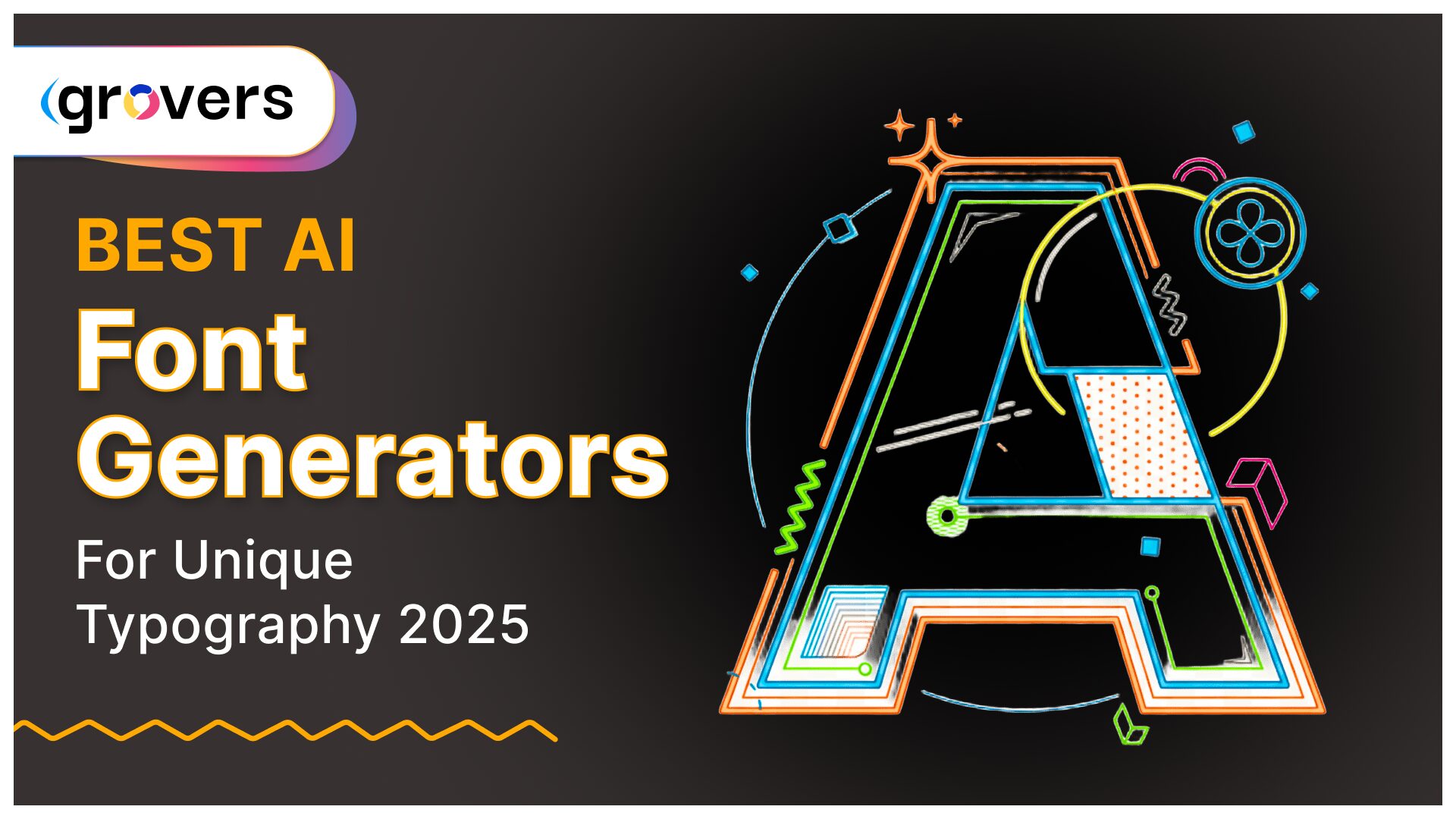Typography is expensive. Custom fonts from professional type designers can cost anywhere from $5,000 to $50,000 depending on the complexity and licensing terms and that’s just for one typeface family. Finding the right font is painful too. You scroll through thousands of options, download a dozen, test them in your design, and still feel like something’s missing.
AI font generators now create custom typography in minutes, not months. Many of them are free. Some can turn your handwriting into an installable font. Others generate completely original typefaces based on simple text prompts. I spent weeks testing these tools. I compared pricing, tested accuracy, checked user reviews, and looked at what features actually matter for designers, marketers, and content creators. Here’s everything you need to know about the best AI font generators in 2025.
What are AI font generators?
AI font generators are tools that use artificial intelligence to create custom typography. Unlike traditional font libraries where you browse existing options, these tools actually generate new typefaces. Technology has evolved dramatically. Early versions just applied filters or transformations to existing fonts. Modern AI font creators analyze design patterns, understand typographic principles, and create original letterforms from scratch.
Some tools specialize in specific use cases:
- Font creation tools generate downloadable, installable font files
- Text effect generators create styled text images for graphics
- Handwriting converters transform your actual writing into digital fonts
- Font pairing tools use AI to suggest complementary typeface combinations
The real advantage? Speed and customization. What took professional type designers weeks or months now happens in seconds or minutes.
How to choose an AI font generator?
Before diving into tool reviews, you need to understand what actually matters when picking an AI font generator. I spent hours reading Reddit threads, user reviews on G2 and Capterra, and analyzing what designers actually complain about. Here’s what I found matters most:
- Output format: Do you need actual font files (OTF/TTF) that you can install and use in any software? Or are you creating styled text images for social media? This determines which tools will even work for you.
- Customization level: Some tools give you full control over weight, spacing, ligatures, and alternate characters. Others offer limited style presets. Designers need more control. Content creators usually don’t.
- Commercial licensing: Many free tools restrict commercial use or require attribution. If you’re doing client work or selling products, licensing is critical. I checked terms of service for every tool in this list.
- Pricing structure: Some charge per font generated. Others offer monthly subscriptions. A few are completely free. I calculated the cost per 1000 font generations to compare fairly.
- Integration options: Does it export files you can use in Photoshop, Figma, or Canva? Can you sync with design systems? Integration matters for workflow efficiency.
- Actual accuracy: Does the tool deliver what it promises? I tested each one and cross-referenced user feedback to verify claims.
Now let’s look at the tools that passed these criteria.
Best AI font generators of 2025
I tested dozens of tools. Most were useless with buggy interfaces, terrible outputs, or just existing fonts with filters slapped on. These are the ones worth your time.
| Tool | Rating | Free plan | Custom fonts | Commercial use | Best for |
| Fontjoy | 4.7/5 | Yes | No | Yes | Font pairing |
| Calligraphr | 4.6/5 | Limited | Yes | Paid only | Handwriting fonts |
| Fontself | 4.5/5 | No | Yes | Yes | Professional designers |
| Adobe Firefly | 4.4/5 | Limited | Effects only | Creative Cloud | Text effects |
| Pixelied | 4.2/5 | Yes | No | Free tier | Social media |
| Font-AI | 4.0/5 | Packs free | Yes | Per font | Web developers |
1. Fontjoy
Fontjoy is a neural network-based tool that generates font combinations. It was created by Jack Qiao and uses deep learning to suggest aesthetically balanced typography pairings.
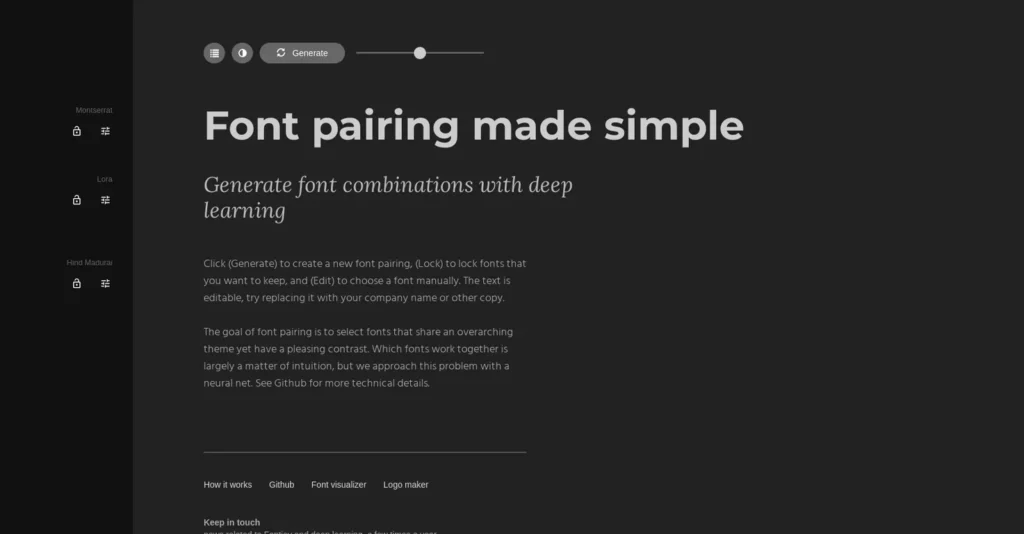
Features:
- Neural network for font pairing
- Contrast control slider
- Lock specific fonts while generating alternatives
- One-click generation
- Direct Google Fonts integration
The tool doesn’t create new fonts. Instead, it solves one of the hardest problems in typography, finding fonts that work well together. You can lock a headline font and let the AI suggest body text options or lock all three (headline, subheading, body) except one and find the perfect match. The contrast slider is brilliant. Move it left for similar styles, right for more contrast between pairings. Most designers I know use this weekly.
Pros:
- Fast and intuitive
- Excellent pairing suggestions
- Free forever
- No signup required
- Uses Google Fonts (all free and legal)
Cons:
- Doesn’t create new fonts
- Limited to Google Fonts library
- No custom font uploads
- No downloadable font files from the tool itself
My take: If you need to pair fonts fast, this is the best free tool available. It won’t create custom fonts, but it’ll save you hours of manual testing. I use it every time I start a new project.
2. Calligraphr
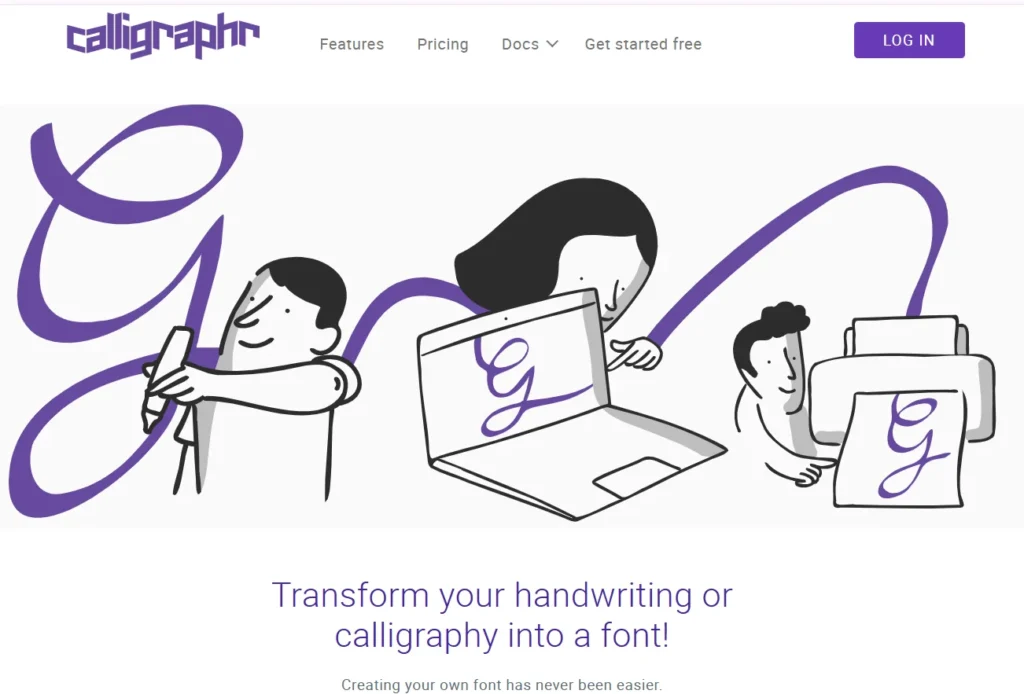
Calligraphr (formerly MyScriptFont) is a handwriting font creator. It converts your actual handwriting or calligraphy into a real, installable font file.
Features:
- Template-based character creation
- Automatic glyph generation
- Ligature support
- Randomization for natural variation
- Multi-language character support
- Export to TTF/OTF formats
The process is straightforward. You download a PDF template with character boxes. Print it, write each letter by hand, scan it back in, and upload. Their AI cleans up your strokes, adjusts spacing, and generates a working font. The free version supports up to 75 characters. Pro accounts let you create complete typefaces with special characters, ligatures, and variations. What impressed me most is the randomization feature. It creates multiple versions of each letter and randomly swaps them when you type. This makes digital text look genuinely handwritten, not repetitive.
Pros:
- Genuinely captures your handwriting
- Professional-quality output
- Affordable pricing
- Great for personalization
- Works on any device
Cons:
- Requires scanning/uploading
- Free version is limited
- Learning curve for advanced features
- Character consistency requires practice
My take: This is the only tool that truly replicates your actual handwriting. Teachers love it for worksheets. Business owners use it for signature fonts. If authenticity matters, nothing else comes close.
3. Fontself
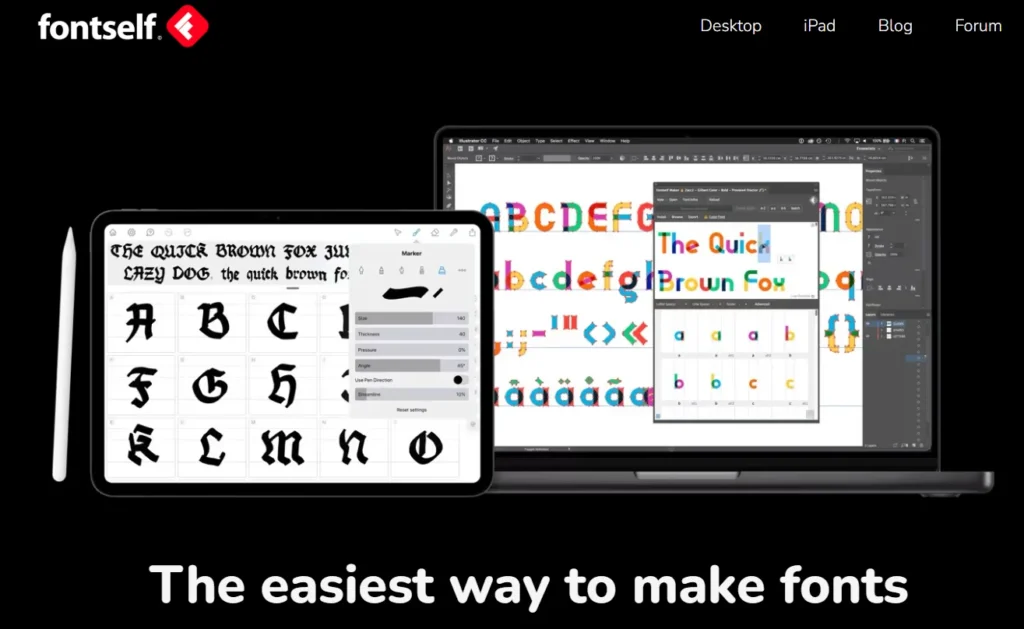
Fontself is a plugin for Adobe Illustrator and Photoshop that lets you create fonts directly inside these apps using AI assistance.
Features:
- Drag and drop font creation
- Color font support
- Variable font generation
- Automatic kerning
- Ligature creation
- Direct export to OTF format
Unlike web-based tools, Fontself works inside Adobe apps you’re already using. Draw a letter in Illustrator, drag it to the Fontself panel, assign it to a character, done. The AI handles technical details like spacing, kerning, and baseline alignment. You focus on design. It supports color fonts and variable fonts, advanced features most tools skip. Professional type designers use Fontself for quick prototyping. It’s not meant to replace proper font design software like Glyphs or FontLab, but for most designers, it’s more than enough.
Pros:
- Professional-grade output
- Works in familiar software
- One-time purchase (no subscription)
- Color and variable font support
- Excellent documentation
Cons:
- Requires Adobe CC subscription
- Steeper learning curve
- Not beginner-friendly
- Mac and Windows only
My take: If you’re already paying for Adobe Creative Cloud and need custom fonts regularly, this is worth every penny. The one-time purchase model beats subscription fatigue.
4. Adobe Firefly
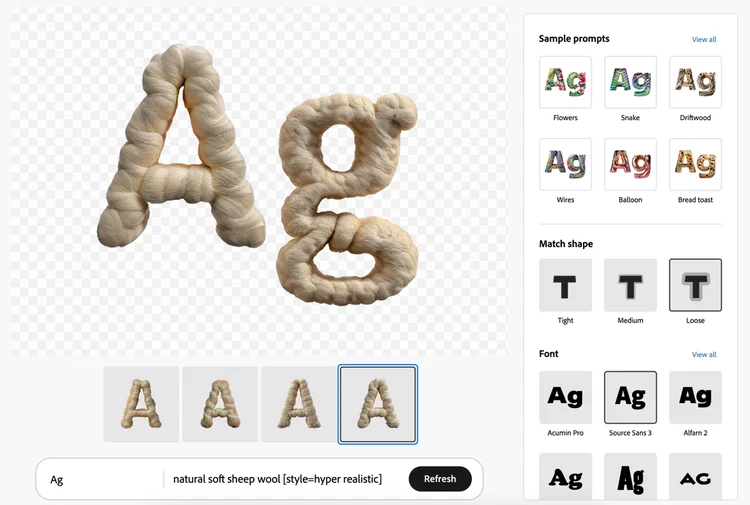
Adobe Firefly is Adobe’s AI generator that includes text effect features. It doesn’t create fonts, it creates styled text with textures, lighting, and dimensional effects.
Features:
- Text to image effects
- Style reference matching
- 3D text rendering
- Texture application
- Color and lighting control
- Direct Creative Cloud integration
You describe what you want: “neon sign text,” “rusty metal letters,” “gold foil typography.” The AI generates multiple variations. Each looks professionally designed with proper lighting, shadows, and textures. The tool shines for marketing materials, social media graphics, and presentation slides. It’s not meant for body text or reading fonts. Think of headers, logos, and attention-grabbing elements. Integration with Creative Cloud makes it seamless if you’re in that setting. Generate in Firefly, refine in Photoshop, use in your design.
Pros:
- Professional output quality
- Excellent texture and lighting
- Adobe ecosystem integration
- Commercial use included
- Regular updates and improvements
Cons:
- Not actual fonts (image-based)
- Requires Adobe account
- Credit system limits free use
- Can’t edit text after generation
My take: If you need styled text for graphics (not installable fonts), this is the best option. The quality justifies Adobe’s pricing if you’re already a Creative Cloud user.
5. Pixelied
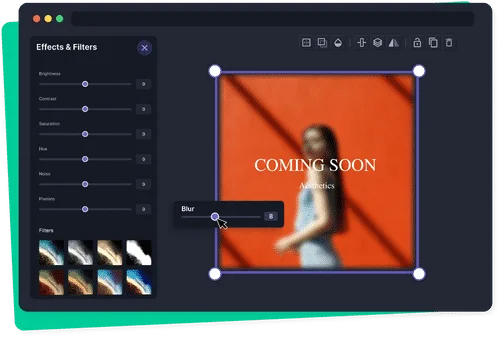
Pixelied offers a free online font generator focused on social media and quick content creation.
Features:
- 100+ text styles
- One-click application
- No signup for basic use
- PNG and JPG export
- Transparent backgrounds
- Basic customization options
This is the simplest tool in the list. Pick a style, type your text, download the image. No complex settings, no learning curve. The styles range from basic to decorative. You won’t create original fonts, but you’ll get decent-looking text images fast. Perfect for Instagram stories, YouTube thumbnails, or quick social posts. The free version includes watermarks on exports. Premium removes them and adds more styles.
Pros:
- Super fast
- Beginner-friendly
- No signup required
- Affordable premium
- Works on mobile
Cons:
- Image output only (not fonts)
- Watermarks on free tier
- Limited customization
- Generic styles
- Not suitable for print
My take: If you’re creating social content daily and need variety without complexity, this works. Don’t expect custom, original typography. Expect fast, decent results.
6. Font-AI
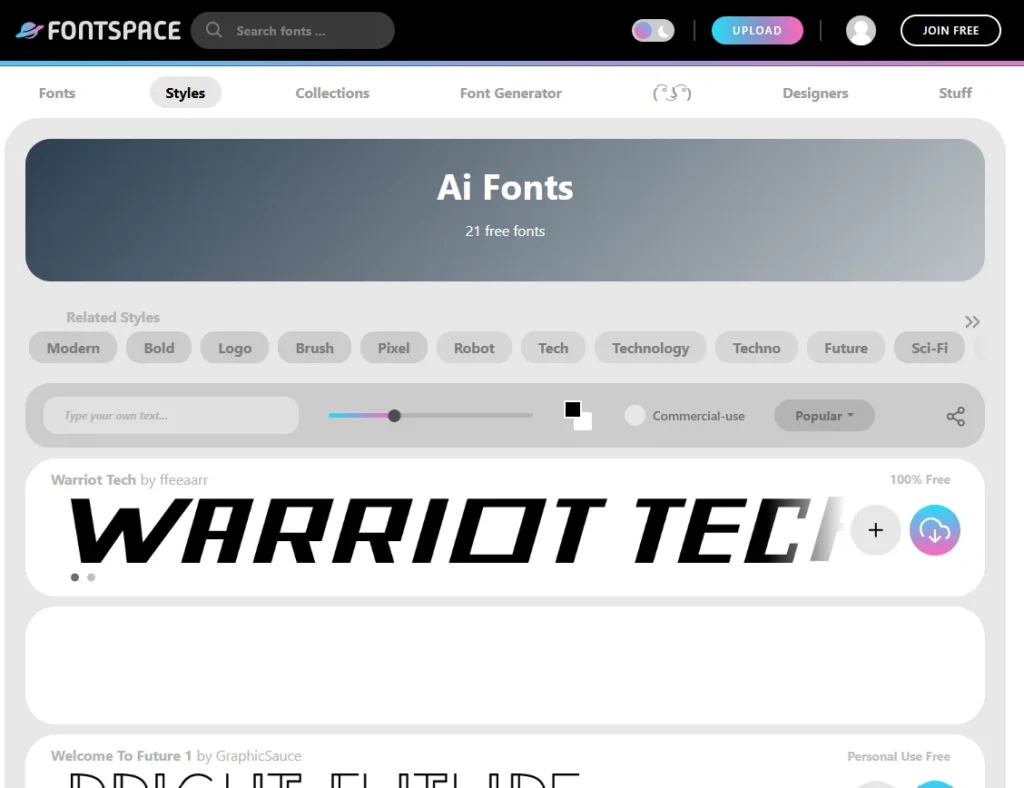
Font-AI generates downloadable font files based on style keywords. It’s straightforward, input descriptors, get a font.
Features:
- Keyword-based generation
- Multiple weight options
- Full character set support
- OTF/TTF export
- Pre-made font packs
- API access
The interface is very simple. No fancy previews or real-time editing. You describe the style you want, generate, download. What I like is that it actually creates working font files, not just images. These fonts install on your computer and work in any software. The pre-made packs are useful for quick projects. Download, test, use. If you need something specific, custom generation takes 5-10 minutes.
Pros:
- Real font files
- Simple process
- Affordable pricing
- API for developers
- No subscription required
Cons:
- Basic interface
- Limited preview options
- Inconsistent quality
- No refunds on bad outputs
- Limited style control
My take: This fills a specific niche, developers and designers who need actual font files without premium pricing. Quality isn’t always perfect, but for the price, it’s acceptable.
Free vs paid AI font generators
Let me be honest about free tools. They work fine for personal projects and testing. Most offer enough features to create decent typography without spending money. But there are clear limitations:
Free plans typically restrict:
- Commercial usage (you can’t use fonts for client work or products)
- Export quality (lower resolution or missing characters)
- Generation limits (only a few fonts per day/month)
- Watermarks on outputs
- Customer support
Paid plans add:
- Full commercial licensing
- Unlimited or high-volume generation
- Priority processing
- Advanced customization
- Multiple export formats
- Support when things break
For hobbyists and personal projects, free plans work great. For professionals, the monthly cost of paid tools usually pays for itself in time saved on a single project. My recommendation? Start free. Test multiple tools. Find what fits your workflow. Upgrade only when you actually need the pro features.
What makes a good AI-generated font?
Not all AI fonts are created equal. I have tested hundreds at this point. Here’s what separates good outputs from raw material:
- Character consistency: Every letter should feel like it belongs to the same family. Weight, stroke width, and stylistic elements should be cohesive. Bad AI fonts mix styles randomly.
- Proper spacing: Kerning (space between letter pairs) matters. Words should be readable, not cramped or too loose. Good tools handle this automatically.
- Complete character sets: A font isn’t useful if it only includes A-Z. You need numbers, punctuation, special characters. Professional tools generate complete sets.
- Readability at different sizes: Test fonts at 12pt and 72pt. If it only looks good at one size, it’s poorly designed. This especially matters for body text.
- Export quality: Font files should install properly and work across different software. Bad exports cause technical headaches.
The best way to judge quality? Use it in a real project. Type a full sentence, not just “The quick brown fox.” See how it performs in context.
Common mistakes when using AI font generators
People mess this up in predictable ways. Here’s what to avoid:
- Ignoring licensing terms: Just because you generated a font doesn’t mean you own it commercially. Read the terms. Using a free-tier font in client work can get you sued.
- Over-styling everything: AI makes it easy to create wild, decorative fonts. But readability matters more than style. Save the fancy fonts for headlines. Use simple, clear fonts for body text.
- Not testing character sets: Your font might look perfect with regular letters but break when you need an ampersand or quotation marks. Test the full set before committing to a design.
- Skipping format compatibility: Some tools export formats that don’t work on all systems. TTF and OTF are safe bets. WebFonts have different requirements.
- Generating without purpose: Don’t create fonts because you can. Have a specific project and goal. Otherwise, you’ll waste time browsing outputs without direction.
- Forgetting about pairing: A single font rarely works alone. Think about what other typefaces you’ll use alongside it. Test combinations early.
How AI font generators actually work
Understanding the technology helps you get better results. Here’s what’s happening under the hood:
Modern AI font generators use neural networks trained on thousands of existing typefaces. They learn typographic principles, stroke weight, x-height, aperture, kerning rules, and stylistic patterns. When you input a prompt like “elegant serif” or “bold graffiti,” the AI searches its learned patterns for matching characteristics. It then generates new letter forms that exhibit those traits while maintaining internal consistency.
Different tools use different approaches:
- GAN-based generators create entirely new designs by learning from example sets
- Style transfer models apply characteristics from reference fonts to new letterforms
- Parameter-based tools let you adjust sliders for weight, width, and other variables
- Template systems modify existing font structures based on your input
The best tools combine multiple approaches. They might use GANs for initial generation, then apply rule-based adjustments for proper spacing and technical requirements. Handwriting tools work differently. They use computer vision to recognize strokes, clean up inconsistencies, and convert pixels to vector paths. Then they apply font hinting and OpenType features to make the output behave like a proper font. The technology keeps improving. Tools from 2023 generated fonts that often looked off. Current 2025 models produce results that fool most people into thinking they’re professionally designed.
Typography basics for better AI results
AI is powerful, but garbage in means garbage out. Understanding basic typography principles helps you create better prompts and evaluate outputs.
- Font anatomy matters: Serif vs sans-serif. Monospace vs proportional. Condensed vs extended. Learn these terms. They dramatically affect what the AI generates.
- Weight and width are different: Weight refers to stroke thickness (light, regular, bold). Width refers to letter spacing (condensed, normal, extended). Specify both for better results.
- Context determines style: Logo fonts need personality. Body text needs readability. UI fonts need clarity at small sizes. Tell the AI what you’re designing for.
- Contrast creates hierarchy: Display fonts (headlines) can be complex. Text fonts (body copy) should be simple. Pair fonts with different levels of complexity.
- Cultural associations matter: Fonts carry meaning. Script fonts feel elegant or casual. Geometric sans-serifs feel modern. Slab serifs feel sturdy or vintage. Think about the message.
When prompting AI tools, be specific. “Modern sans-serif, geometric, medium weight, for tech startup branding” gets better results than just “cool font.”
The future of AI typography
Technology is evolving fast. Here’s what’s coming based on current development trends:
- Real-time contextual generation: Instead of generating a complete font file, AI will create letterforms on-demand based on surrounding content. Fonts that adapt to meaning, mood, or even reader demographics.
- Voice-controlled creation: Describe fonts verbally and see instant results. No more typing prompts or adjusting sliders. This is already in beta testing.
- Variable font automation: AI that generates entire variable font families with multiple axes (weight, width, slant, optical size) from a single prompt. Currently, this requires significant manual work.
- Better handwriting accuracy: Current tools capture your handwriting reasonably well. Next-gen systems will perfectly replicate pen pressure, ink flow, and natural variations. The results will be indistinguishable from actual writing.
- Integrated design systems: AI won’t just create fonts—it’ll suggest entire typographic systems (headline, subhead, body, caption) that work together perfectly. Including recommended sizes, spacing, and use cases.
- Copyright-aware generation: Tools that verify outputs don’t accidentally replicate existing commercial fonts. This is crucial for legal protection.
Some of this tech exists in research labs right now. It’ll hit consumer tools within 12-18 months. For now, current AI font generators already save massive amounts of time and money compared to traditional methods. That’s enough.
Conclusion
Typography used to be expensive, time-consuming, and exclusive to professionals with specialized skills. AI has completely changed that in 2025. The tools in this list represent the current state of AI typography. Some excel at specific tasks like font pairing (Fontjoy) or handwriting conversion (Calligraphr). Others offer professional-grade creation (Fontself) or quick social graphics (Pixelied). My top pick? If you need actual custom fonts regularly, start with Calligraphr if you want handwritten styles, or Fontself if you need full design control. If you just need to pair existing fonts well, Fontjoy is unbeatable and free.
For social media managers and content creators who need styled text images fast, Pixelied or Adobe Firefly work great depending on quality requirements. The best approach? Test multiple tools. Most offer free tiers or trials. See what fits your workflow before committing to paid plans. Typography shapes how people experience your content. AI font generators put professional-quality custom typefaces within reach of everyone. The technology is here, it works, and it’s only getting better. Time to make your text look as good as what it says.
FAQs
Can I use AI-generated fonts commercially?
It depends entirely on the tool and plan. Most free tiers prohibit commercial use or require attribution. Paid plans typically include commercial licenses, but read the specific terms. Some tools let you use outputs commercially even on free plans (like Fontjoy since it uses Google Fonts). Others don’t. When in doubt, email their support team before using fonts in client work.
How long does it take to create a custom font with AI?
Simple text effects generate in seconds. Complete installable fonts take 5-15 minutes depending on the tool and customization level. Handwriting fonts require about 20-30 minutes including the time to fill templates and upload. For context, traditional font design takes weeks to months for a professional. AI is dramatically faster.
Do I need design skills to use AI font generators?
Not for basic use. Most tools have simple interfaces where you type text and pick from generated options. However, understanding typography basics helps you evaluate outputs and choose fonts that actually work for your project. You can start with zero skills and learn as you go. Just study what works and what doesn’t.
Are AI-generated fonts as good as professionally designed fonts?
For most use cases, yes. AI tools in 2025 produce fonts that look professionally designed to average users. Expert typographers can sometimes spot AI-generated fonts, but the gap is closing fast. For branding that’ll last decades, hiring a type designer might still make sense. For time-sensitive projects, marketing materials, or exploratory work, AI fonts are more than adequate.
What’s the difference between font files and text effect images?
Font files (TTF/OTF) install on your computer and work like any typeface. You can type anything, change sizes, apply to any text. Text effect images are single-use graphics. They look great but can’t be edited or reused flexibly. Choose font files for ongoing projects. Choose text effects for one-off graphics like social media posts.
